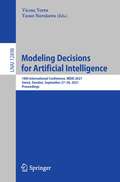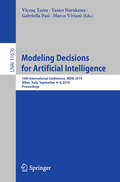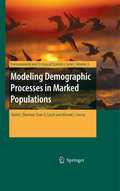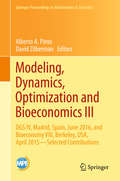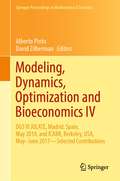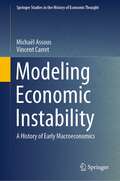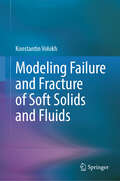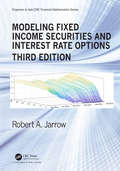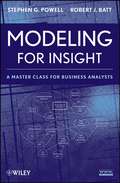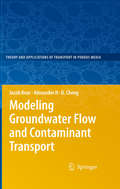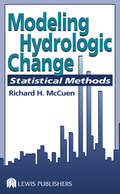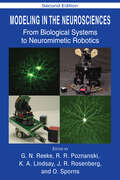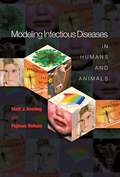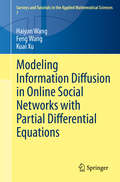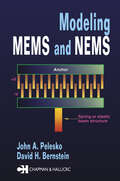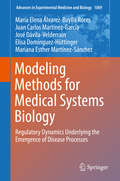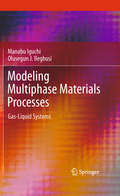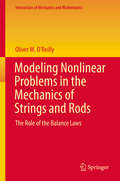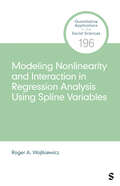- Table View
- List View
Modeling Count Data
by Joseph M. HilbeThis entry-level text offers clear and concise guidelines on how to select, construct, interpret, and evaluate count data. Written for researchers with little or no background in advanced statistics, the book presents treatments of all major models using numerous tables, insets, and detailed modeling suggestions. It begins by demonstrating the fundamentals of linear regression and works up to an analysis of the Poisson and negative binomial models, and to the problem of overdispersion. Examples in Stata, R, and SAS code enable readers to adapt models for their own purposes, making the text an ideal resource for researchers working in public health, ecology, econometrics, transportation, and other related fields.
Modeling Decisions for Artificial Intelligence: 18th International Conference, MDAI 2021, Umeå, Sweden, September 27–30, 2021, Proceedings (Lecture Notes in Computer Science #12898)
by Vicenç Torra Yasuo NarukawaThis book constitutes the refereed proceedings of the 18th International Conference on Modeling Decisions for Artificial Intelligence, MDAI 2021, held in Umeå, Sweden, in September 2021.* The 24 papers presented in this volume were carefully reviewed and selected from 50 submissions. Additionally, 3 invited papers were included. The papers discuss different facets of decision processes in a broad sense and present research in data science, data privacy, aggregation functions, human decision making, graphs and social networks, and recommendation and search. The papers are organized in the following topical sections: aggregation operators and decision making; approximate reasoning; machine learning; data science and data privacy. *The conference was held virtually due to the COVID-19 pandemic.
Modeling Decisions for Artificial Intelligence: 15th International Conference, MDAI 2018, Mallorca, Spain, October 15–18, 2018, Proceedings (Lecture Notes in Computer Science #11144)
by Vicenç Torra Yasuo Narukawa Isabel Aguiló Manuel González-HidalgoThis book constitutes the proceedings of the 15th International Conference on Modeling Decisions for Artificial Intelligence, MDAI 2018, held in Mallorca, Spain, in October 2018.The 24 papers presented in this volume were carefully reviewed and selected from 43 submissions. The book also contains one invited talk in full paper length. The papers were organized in topical sections named: aggregation operators, fuzzy measures and integrals; decision making; clustering and classification; and data privacy and security.
Modeling Decisions for Artificial Intelligence: 16th International Conference, MDAI 2019, Milan, Italy, September 4–6, 2019, Proceedings (Lecture Notes in Computer Science #11676)
by Vicenç Torra Yasuo Narukawa Gabriella Pasi Marco VivianiThis book constitutes the refereed proceedings of the 16th International Conference on Modeling Decisions for Artificial Intelligence, MDAI 2019, held in Milan, Italy, in September 2019. The 30 papers presented in this volume were carefully reviewed and selected from 50 submissions. They discuss different facets of decision processes in a broad sense and present research in data science, data privacy, aggregation functions, human decision making, graphs and social networks, and recommendation and search. The papers are organized in the following topical sections: aggregation operators and decision making; data science and data mining; and data privacy and security.
Modeling Demographic Processes in Marked Populations
by David L. Thomson Michael J. Conroy Evan G. CoochThis book brings together biologists and statisticians in an interdisciplinary synthesis to develop new methods to overcome the most significant challenges and constraints faced by quantitative biologists seeking to model demographic rates. The book is centered on the ten key areas in the field where important problems in demographic analysis are being solved with new statistical methods. Each area presents one overview written by an acknowledged expert in this field, and four original research contributions. The 10 key areas are: - Abundance estimation; direct, proxies and point counts; Population dynamics; - Combining sources of information; - Dispersal movement and migration; - State uncertainty: assignment error and unobservable states; - Robust design: sampling, applications and advances; - Bayesian applications: advances, random effects and hierarchical models; - Evolutionary ecology; - Wildlife and conservation management; - Software developments for the modelling of demographic rates in marked populations.
Modeling, Dynamics, Optimization and Bioeconomics III: Contributions From Dgs Iii And The 7th Bioeconomy Conference 2014 (Springer Proceedings in Mathematics & Statistics #195)
by Alberto A. Pinto David ZilbermanThe research and review papers presented in this volume provide an overview of the main issues, findings, and open questions in cutting-edge research on the fields of modeling, optimization and dynamics and their applications to biology, economics, energy, finance, industry, physics and psychology. Given the scientific relevance of the innovative applications and emerging issues they address, the contributions to this volume, written by some of the world’s leading experts in mathematics, economics and other applied sciences, will be seminal to future research developments and will spark future works and collaborations. The majority of the papers presented in this volume were written by participants of the 4th International Conference on Dynamics, Games and Science: Decision Models in a Complex Economy (DGS IV), held at the National Distance Education University (UNED) in Madrid, Spain in June 2016 and of the 8th Berkeley Bioeconomy Conference: The Future of Biofuels, held at the UC Berkeley Alumni House in April 2015.
Modeling, Dynamics, Optimization and Bioeconomics IV: DGS VI JOLATE, Madrid, Spain, May 2018, and ICABR, Berkeley, USA, May–June 2017—Selected Contributions (Springer Proceedings in Mathematics & Statistics #365)
by Alberto Pinto David ZilbermanThis book, following the three published volumes of the book, provides the main purpose to collect research papers and review papers to provide an overview of the main issues, results, and open questions in the cutting-edge research on the fields of modeling, optimization, and dynamics and their applications to biology, economy, energy, industry, physics, psychology and finance. Assuming the scientific relevance of the presenting innovative applications as well as merging issues in these areas, the purpose of this book is to collect papers of the world experts in mathematics, economics, and other applied sciences that is seminal to the future research developments. The majority of the papers presented in this book is authored by the participants in The Joint Meeting 6th International Conference on Dynamics, Games, and Science – DGSVI – JOLATE and in the 21st ICABR Conference. The scientific scope of the conferences is focused on the fields of modeling, optimization, and dynamics and their applications to biology, economy, energy, industry, physics, psychology, and finance. Assuming the scientific relevance of the presenting innovative applications as well as merging issues in these areas, the purpose of the conference is to bring together some of the world experts in mathematics, economics, and other applied sciences that reinforce ongoing projects and establish future works and collaborations.
Modeling Economic Instability: A History of Early Macroeconomics (Springer Studies in the History of Economic Thought)
by Michaël Assous Vincent CarretThis book offers a fresh perspective on the early history of macroeconomics, by examining the macro-dynamic models developed from the late 1920s to the late 1940s, and their treatment of economic instability. It first explores the differences and similarities between the early mathematical business cycle models developed by Ragnar Frisch, Michal Kalecki, Jan Tinbergen and others, which were presented at meetings of the Econometric Society and discussed in private correspondence. By doing so, it demonstrates the diversity of models representing economic phenomena and especially economic crises and instability. Jan Tinbergen emerged as one of the most original and pivotal economists of this period, before becoming a leader of the macro-econometric movement, a role for which he is better known. His emphasis on economic policy was later mirrored in the United States in Paul Samuelson’s early work on business cycles analysis, which, drawing on Alvin Hansen, aimed at interpreting the 1937-1938 recession. The authors then show that the subsequent shift in Samuelson's approach, from the study of business cycle trajectories to the comparison of equilibrium points, provided a response to the econometricians' critique of early Keynesian models. In the early 1940s, Samuelson was able to link together the tools that had been developed by the econometricians and the economic content that was at the heart of the so-called Keynesian revolution. The problem then shifted from business cycle trajectories to the disequilibrium between economic aggregates, and the issues raised by the global stability of full employment equilibrium. This was addressed by Oskar Lange, who presented an analysis of market coordination failures, and Lawrence Klein, Samuelson's first PhD student, who pursued empirical work in this direction. The book highlights the various visions and approaches that were embedded in these macro-dynamic models, and that their originality is of interest to today's model builders as well as to students and anyone interested in how new economic ideas come to be developed.
Modeling Failure and Fracture of Soft Solids and Fluids
by Konstantin VolokhThis book applies approaches of nonlinear continuum mechanics used to model fracture and failures in soft materials. Two physical observations underlie mathematical theories described in this book. First, the energy of molecular bonds is bounded and, consequently, the macroscopic strain energy must be bounded. Second, the broken bonds are diffused and, consequently, highly localized material sink takes place. The first observation allows describing material failure as the damage initiation. The second observation allows modeling cracks as damage localization and propagation. This book builds on the experiences of “Soft Matter Mechanics” by Konstantin Volokh.
Modeling Fixed Income Securities and Interest Rate Options (Chapman and Hall/CRC Financial Mathematics Series)
by Robert JarrowModeling Fixed Income Securities and Interest Rate Options, Third Edition presents the basics of fixed-income securities in a way that, unlike competitive texts, requires a minimum of prerequisites. While other books focus heavily on institutional details of the bond market, all of which could easily be learned "on the job," the third edition of this classic textbook is more focused with presenting a coherent theoretical framework for understanding all basic models. The author’s unified approach—the Heath Jarrow Morton model—under which all other models are presented as special cases, enhances understanding of the material. The author’s pricing model is widely used in today’s securities industry. This new edition offers many updates to align with advances in the research and requires a minimum of prerequisites while presenting the basics of fixed-income securities. Highlights of the Third Edition Chapters 1-16 completely updated to align with advances in research Thoroughly eliminates out-of-date material while advancing the presentation Includes an ample amount of exercises and examples throughout the text which illustrate key concepts .
Modeling for Insight
by Stephen G. Powell Robert J. BattPraise for Modeling for Insight"Most books on modeling are either too theoretical or too focused on the mechanics of programming. Powell and Batt's emphasis on using simple spreadsheet models to gain business insight (which is, after all, the name of the game) is what makes this book stand head and shoulders above the rest. This clear and practical book deserves a place on the shelf of every business analyst."--Jonathan Koomey, PhD, Lawrence Berkeley National Laboratory and Stanford University, author of Turning Numbers into Knowledge: Mastering the Art of Problem SolvingMost business analysts are familiar with using spreadsheets to organize data and build routine models. However, analysts often struggle when faced with examining new and ill-structured problems. Modeling for Insight is a one-of-a-kind guide to building effective spreadsheet models and using them to generate insights. With its hands-on approach, this book provides readers with an effective modeling process and specific modeling tools to become a master modeler.The authors provide a structured approach to problem-solving using four main steps: frame the problem, diagram the problem, build a model, and generate insights. Extensive examples, graduated in difficulty, help readers to internalize this modeling process, while also demonstrating the application of important modeling tools, including:Influence diagramsSpreadsheet engineeringParameterizationSensitivity analysisStrategy analysisIterative modelingThe real-world examples found in the book are drawn from a wide range of fields such as financial planning, insurance, pharmaceuticals, advertising, and manufacturing. Each chapter concludes with a discussion on how to use the insights drawn from these models to create an effective business presentation. Microsoft Office Excel and PowerPoint are used throughout the book, along with the add-ins Premium Solver, Crystal Ball, and Sensitivity Toolkit. Detailed appendices guide readers through the use of these software packages, and the spreadsheet models discussed in the book are available to download via the book's related Web site. Modeling for Insight is an ideal book for courses in engineering, operations research, and management science at the upper-undergraduate and graduate levels. It is also a valuable resource for consultants and business analysts who often use spreadsheets to better understand complex problems.
Modeling, Functions, and Graphs: Algebra for College Students
by Katherine Yoshiwara Bruce YoshiwaraThe Fourth Edition of Yoshiwara and Yoshiwara's MODELING, FUNCTIONS, AND GRAPHS: ALGEBRA FOR COLLEGE STUDENTS includes content found in a typical algebra course, along with introductions to curve-fitting and display of data. Yoshiwara and Yoshiwara focus on three core themes throughout their textbook: Modeling, Functions, and Graphs. In their work of modeling and functions, the authors utilize the Rule of Four, which is that all problems should be considered using algebraic, numerical, graphical, and verbal methods. The authors motivate students to acquire the skills and techniques of algebra by placing them in the context of simple applications that use real-life data.
Modeling Groundwater Flow and Contaminant Transport
by Jacob Bear Alexander H.-D. ChengIn many parts of the world, groundwater resources are under increasing threat from growing demands, wasteful use, and contamination. To face the challenge, good planning and management practices are needed. A key to the management of groundwater is the ability to model the movement of fluids and contaminants in the subsurface. The purpose of this book is to construct conceptual and mathematical models that can provide the information required for making decisions associated with the management of groundwater resources, and the remediation of contaminated aquifers. The basic approach of this book is to accurately describe the underlying physics of groundwater flow and solute transport in heterogeneous porous media, starting at the microscopic level, and to rigorously derive their mathematical representation at the macroscopic levels. The well-posed, macroscopic mathematical models are formulated for saturated, single phase flow, as well as for unsaturated and multiphase flow, and for the transport of single and multiple chemical species. Numerical models are presented and computer codes are reviewed, as tools for solving the models. The problem of seawater intrusion into coastal aquifers is examined and modeled. The issues of uncertainty in model input data and output are addressed. The book concludes with a chapter on the management of groundwater resources. Although one of the main objectives of this book is to construct mathematical models, the amount of mathematics required is kept minimal.
Modeling Hydrologic Change: Statistical Methods
by Richard H. McCuenModeling hydrologic changes and predicting their impact on watersheds is a dominant concern for hydrologists and other water resource professionals, civil and environmental engineers, and urban and regional planners. As such changes continue, it becomes more essential to have the most up-to-date tools with which to perform the proper analyses and m
Modeling in the Neurosciences: From Biological Systems to Neuromimetic Robotics
by G. N. Reeke R. R. Poznanski K. A. Lindsay J. R. Rosenberg O. SpornsComputational models of neural networks have proven insufficient to accurately model brain function, mainly as a result of simplifications that ignore the physical reality of neuronal structure in favor of mathematically tractable algorithms and rules. Even the more biologically based "integrate and fire" and "compartmental" styles of modeling suff
Modeling Infectious Diseases in Humans and Animals
by Matt J. Keeling Pejman RohaniFor epidemiologists, evolutionary biologists, and health-care professionals, real-time and predictive modeling of infectious disease is of growing importance. This book provides a timely and comprehensive introduction to the modeling of infectious diseases in humans and animals, focusing on recent developments as well as more traditional approaches.Matt Keeling and Pejman Rohani move from modeling with simple differential equations to more recent, complex models, where spatial structure, seasonal "forcing," or stochasticity influence the dynamics, and where computer simulation needs to be used to generate theory. In each of the eight chapters, they deal with a specific modeling approach or set of techniques designed to capture a particular biological factor. They illustrate the methodology used with examples from recent research literature on human and infectious disease modeling, showing how such techniques can be used in practice. Diseases considered include BSE, foot-and-mouth, HIV, measles, rubella, smallpox, and West Nile virus, among others. Particular attention is given throughout the book to the development of practical models, useful both as predictive tools and as a means to understand fundamental epidemiological processes. To emphasize this approach, the last chapter is dedicated to modeling and understanding the control of diseases through vaccination, quarantine, or culling.Comprehensive, practical introduction to infectious disease modelingBuilds from simple to complex predictive modelsModels and methodology fully supported by examples drawn from research literaturePractical models aid students' understanding of fundamental epidemiological processesFor many of the models presented, the authors provide accompanying programs written in Java, C, Fortran, and MATLABIn-depth treatment of role of modeling in understanding disease control
Modeling Information Diffusion in Online Social Networks with Partial Differential Equations (Surveys and Tutorials in the Applied Mathematical Sciences #7)
by Feng Wang Haiyan Wang Kuai XuThe book lies at the interface of mathematics, social media analysis, and data science. Its authors aim to introduce a new dynamic modeling approach to the use of partial differential equations for describing information diffusion over online social networks. The eigenvalues and eigenvectors of the Laplacian matrix for the underlying social network are used to find communities (clusters) of online users. Once these clusters are embedded in a Euclidean space, the mathematical models, which are reaction-diffusion equations, are developed based on intuitive social distances between clusters within the Euclidean space. The models are validated with data from major social media such as Twitter. In addition, mathematical analysis of these models is applied, revealing insights into information flow on social media. Two applications with geocoded Twitter data are included in the book: one describing the social movement in Twitter during the Egyptian revolution in 2011 and another predicting influenza prevalence. The new approach advocates a paradigm shift for modeling information diffusion in online social networks and lays the theoretical groundwork for many spatio-temporal modeling problems in the big-data era.
Modeling MEMS and NEMS
by John A. Pelesko David H. BernsteinDesigning small structures necessitates an a priori understanding of various device behaviors. The way to gain such understanding is to construct, analyze, and interpret the proper mathematical model.Through such models, Modeling MEMS and NEMS illuminates microscale and nanoscale phenomena, thereby facilitating the design and optimization o
Modeling Methods for Marine Science
by David M. Glover William J. Jenkins Scott C. DoneyThis advanced textbook on modeling, data analysis and numerical techniques for marine science has been developed from a course taught by the authors for many years at the Woods Hole Oceanographic Institute. The first part covers statistics: singular value decomposition, error propagation, least squares regression, principal component analysis, time series analysis and objective interpolation. The second part deals with modeling techniques: finite differences, stability analysis and optimization. The third part describes case studies of actual ocean models of ever increasing dimensionality and complexity, starting with zero-dimensional models and finishing with three-dimensional general circulation models. Throughout the book the general principles and goals of scientific visualization are emphasized through technique and application. Ideal as a textbook for advanced students of oceanography on courses in data analysis and numerical modeling, the book is also an invaluable resource for a broad range of scientists undertaking modeling in chemical, biological, geological and physical oceanography.
Modeling Methods for Medical Systems Biology: Regulatory Dynamics Underlying the Emergence of Disease Processes (Advances in Experimental Medicine and Biology #1069)
by María Elena Álvarez-Buylla Roces Juan Carlos Martínez-García José Dávila-Velderrain Elisa Domínguez-Hüttinger Mariana Esther Martínez-SánchezThis book contributes to better understand how lifestyle modulations can effectively halt the emergence and progression of human diseases. The book will allow the reader to gain a better understanding of the mechanisms by which the environment interferes with the bio-molecular regulatory processes underlying the emergence and progression of complex diseases, such as cancer. Focusing on key and early cellular bio-molecular events giving rise to the emergence of degenerative chronic disease, it builds on previous experience on the development of multi-cellular organisms, to propose a mathematical and computer based framework that allows the reader to analyze the complex interplay between bio-molecular processes and the (micro)-environment from an integrative, mechanistic, quantitative and dynamical perspective. Taking the wealth of empirical evidence that exists it will show how to build and analyze models of core regulatory networks involved in the emergence and progression of chronic degenerative diseases, using a bottom-up approach.
Modeling Monetary Economies
by Scott Freeman Bruce Champ Joseph HaslagThe approach of this text is to teach monetary economics using the classical paradigm of rational agents in a market setting. Too often monetary economics has been taught as a collection of facts about existing institutions for students to memorize. By teaching from first principles instead, the authors aim to instruct students not only in the monetary policies and institutions that exist today in the United States and Canada, but also in what policies and institutions may or should exist tomorrow and elsewhere. The text builds on a simple, clear monetary model and applies this framework consistently to a wide variety of monetary questions. The authors have added in this third edition new material on money as a means of replacing imperfect social record keeping, the role of currency in banking panics, and a description of the policies implemented to deal with the banking crises that began in 2007.
Modeling Multiphase Materials Processes
by Manabu Iguchi Olusegun J. IlegbusiModeling Multiphase Materials Processes: Gas-Liquid Systems describes the methodology and application of physical and mathematical modeling to multi-phase flow phenomena in materials processing. The book focuses on systems involving gas-liquid interaction, the most prevalent in current metallurgical processes. The performance characteristics of these processes are largely dependent on transport phenomena. This volume covers the inherent characteristics that complicate the modeling of transport phenomena in such systems, including complex multiphase structure, intense turbulence, opacity of fluid, high temperature, coupled heat and mass transfer, chemical reactions in some cases, and poor wettability of the reactor walls. Also discussed are: solutions based on experimental and numerical modeling of bubbling jet systems, recent advances in the modeling of nanoscale multi-phase phenomena and multiphase flows in micro-scale and nano-scale channels and reactors. Modeling Multiphase Materials Processes: Gas-Liquid Systems will prove a valuable reference for researchers and engineers working in mathematical modeling and materials processing.
Modeling Nonlinear Problems in the Mechanics of Strings and Rods: The Role of the Balance Laws (Interaction of Mechanics and Mathematics)
by Oliver M. O'ReillyThis book presents theories of deformable elastic strings and rods and their application to broad classes of problems. Readers will gain insights into the formulation and analysis of models for mechanical and biological systems. Emphasis is placed on how the balance laws interplay with constitutive relations to form a set of governing equations. For certain classes of problems, it is shown how a balance of material momentum can play a key role in forming the equations of motion. The first half of the book is devoted to the purely mechanical theory of a string and its applications. The second half of the book is devoted to rod theories, including Euler’s theory of the elastica, Kirchhoff ’s theory of an elastic rod, and a range of Cosserat rod theories. A variety of classic and recent applications of these rod theories are examined. Two supplemental chapters, the first on continuum mechanics of three-dimensional continua and the second on methods from variational calculus, are included to provide relevant background for students.This book is suited for graduate-level courses on the dynamics of nonlinearly elastic rods and strings.
Modeling Nonlinearity and Interaction in Regression Analysis Using Spline Variables (Quantitative Applications in the Social Sciences)
by Roger A. Wojtkiewicz"Spline variables and their interactions play a crucial role in the field of social science. This book offers a comprehensive and detailed exploration of this method, providing valuable insights and information for researchers in the field." --Man-Kit Lei, The University of Georgia This volume addresses the issue of linear constraints in regression modeling. Author Roger A. Wojtkiewicz uses the method of knotted spline variables (also known as piecewise linear regression) and a new method involving group spline variables to model nonlinearity in a variety of situations. Using spline variables to model nonlinearity allows researchers to specify unrestricted models for models that involve interval variables, allowing for greater flexibility in modeling any possible interaction.
Modeling Nonlinearity and Interaction in Regression Analysis Using Spline Variables (Quantitative Applications in the Social Sciences)
by Roger A. Wojtkiewicz"Spline variables and their interactions play a crucial role in the field of social science. This book offers a comprehensive and detailed exploration of this method, providing valuable insights and information for researchers in the field." --Man-Kit Lei, The University of Georgia This volume addresses the issue of linear constraints in regression modeling. Author Roger A. Wojtkiewicz uses the method of knotted spline variables (also known as piecewise linear regression) and a new method involving group spline variables to model nonlinearity in a variety of situations. Using spline variables to model nonlinearity allows researchers to specify unrestricted models for models that involve interval variables, allowing for greater flexibility in modeling any possible interaction.

